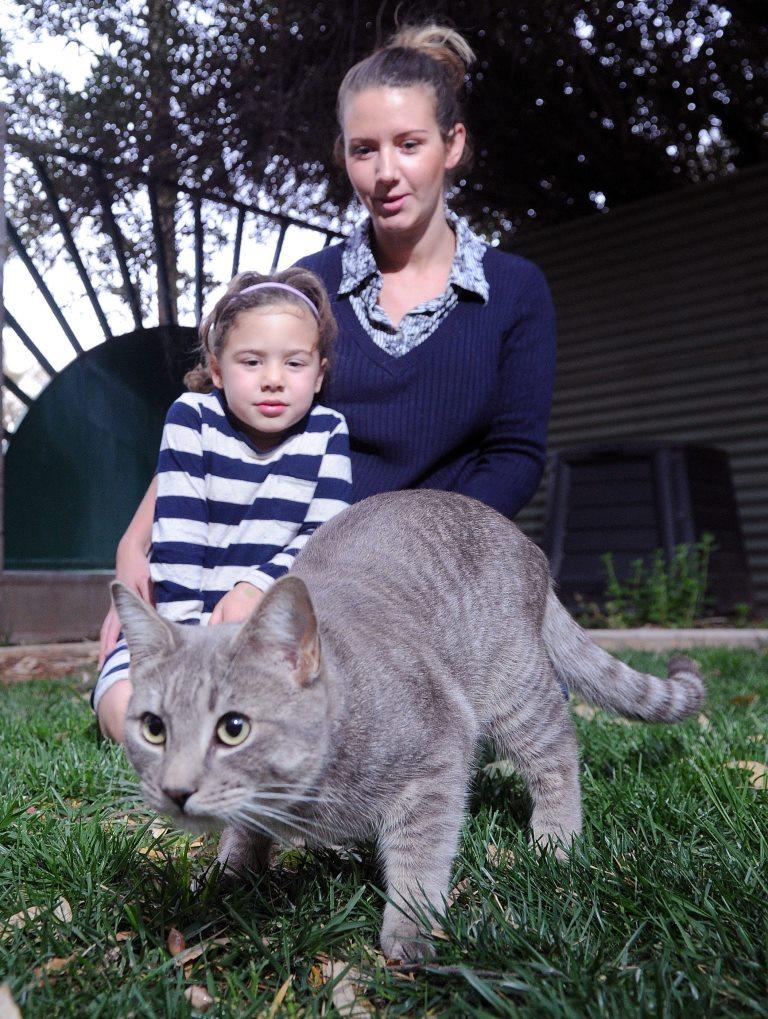Domestic Cat Monitoring and Awareness in Alice Springs

Land for Wildlife is monitoring domestic cats with harness-mounted GPS units, collar-mounted Eyenimal video surveillance cameras and through analysis of scats. The aim of the monitoring is to highlight the movement patterns and behaviour of domestic cats when roaming away from the home. We also conducted owner surveys to gauge the opinion of domestic cat owners before and after monitoring regarding domestic cat management.
The Domestic Cat Monitoring and Awareness in Alice Springs program was established to engage domestic cat owners regarding the travelling patterns of their feline friends, to help them to make informed and responsible cat management decisions. The project focuses on the movement and behaviour of pet cats in Alice Springs and Tennant Creek.

Cat Tracking
By fitting domestic cats with a GPS-tracker, we identify the movements of domestic cats when they are away from home. The information can help owners to understand the impact that their cat management is having on the local community and wildlife.
Data obtained shows that cats roam further from home than the owners had anticipated and has sparked conversation regarding responsible domestic cat ownership.
Read more about the Cat Tracking…
Video Surveillance
A trial of the Eyenimal Cat Camera was conducted to determine the behaviour of the cats while roaming. Recording video footage of cats while outside of the house helped to highlight what the cat was doing while roaming, by capturing periods of sleep, stalking, eating, and walking.
You can see an example of TeeGee’s adventures in the video below.
Read more about the Cat Surveillance…
Scat Analysis
Scats were collected from the monitored domestic cats to determine the diet of the cat when away from home. Any wildlife consumed can be detected in scats as fragments of bone or hair. The findings can identify the impact of domestic cats’ roaming activities on the local wildlife and encourage discussion regarding responsible cat ownership.
Read more about the Cat Scat Analysis…
Domestic Cat Management
Protecting our cats and our wildlife relies on responsible management!
Management of owned cats can be varied, ranging from well-cared for individuals that are maintained indoors, to outdoor cats that do not stray from home, and at the extreme scale to roaming cats that may have a negative impact on their surroundings.
Poorly managed domestic cats can:
- Have a negative impact on wildlife populations through predation or altering home ranges of wildlife by their presence in the environment
- Become a nuisance to neighbours by spraying, depositing scats, yowl, or harassing neighbouring pets. Roaming domestic cats can also be a nuisance in the neighbourhood by deterring native animals from the area (g. birds) that neighbours may wish to attract
- Have an increased risk of catching or transmitting disease from wild or domestic animals, or humans, as well as infection from other sources
- Secondarily add to the feral cat population by mating with feral cats (if not de-sexed) or directly contributing to the feral cat population when not returning home
- Suffer physical abuse from unfriendly community members
- Suffer injury as a result of roaming behaviours, interaction with other stray or neighbouring animals, or vehicular accidents. In some cases, this can result in a hefty veterinary bill or a great loss to the family
- Be trapped when wandering off the property, resulting in impounding fees from the local shelter
Alice Springs Town Council by-laws state that a cat is at large when it ventures from its yard. In such cases, a cat can be impounded.
What can you do to manage your cat appropriately?
- De-sex your cat to prevent it from adding to the feral cat population
- Microchip and register your cat with the Alice Springs Town Council so that it can be returned to you if it goes missing
- Keep your cat indoors so that it is not a nuisance to neighbours and does not negatively impact the local wildlife
- Install an outdoor cat play area to provide your cat with environmental stimuli that won’t impact on the local wildlife
- Provide toys and play options for your cat to keep it stimulated indoors
- Fit your cat with a bell, luminescent scrunchie, sonar or other device to alert wildlife to its presence
- Provide food ad libitum so that your cat has adequate access to food, to limit its dependence on wildlife as a food source. (Note: you should consult your veterinarian before feeding your cat ad libitum, or if the weight of the cat is being impacted through a modified feeding regime)
- Don’t release unwanted animals into the bush
Learn More
Download the Domestic Cat Monitoring and Awareness report containing the program summary and detailed results! (6.9 MB)
Land for Wildlife have produced an information resource for cat owners in the 2015-2016 funding round: Where is Your Cat Now? Download the pamphlet to read more about the project.
We have since updated the pamphlet with some additional information about the monitoring program, as part of the 2016-2017 funding round. Download the pamphlet to see the updated project information.
Get Involved!
Do you know where your cat goes and what it gets up to?
Please let us know if you are interested in taking part in the monitoring program to see where cats wander and what they see.
Contact us at lfw@lowecol.com.au or by calling 08 89 555 222.
This project is supported by Territory Natural Resource Management, through funding from the Australian Government’s National Landcare Programme.
The Domestic Cat Monitoring and Awareness in Alice Springs project is conducted with approval from the Charles Darwin University Animal Ethics Committee (Project 16019 Monitoring Domestic Cats In & Around Alice Springs).





